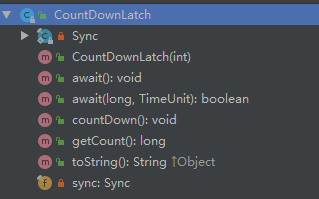1、CountDownLatch简介
CountDownLatch是我们日常开发中经常用到的一个多线程工具类,它在完成一组正在其他线程中执行的操作之前,允许一个或多个线程一直等待,因此它的作用和join()方法类似,但是比join()方法更加的灵活。CountDownLatch在内部提供了一个计数器,每个线程完成任务后将计数器减一,当计数器减为0时所有等待在CountDownLatch的线程才会被唤醒。
2、CountDownLatch示例
CountDownLatch最常见的使用场景就是开启多个线程同时执行某个任务,等到所有任务都执行完再统计汇总结果,比如火箭发射。在火箭发射前,为了保证万无一失,往往还要进行各项设备、仪器的检测。只有等到所有的检查完毕后,引擎才能点火。那么在检测环节当然是多个检测项可以同时进行的。代码实现:
public class CountDownLatchTest {
static CountDownLatch countDownLatch = new CountDownLatch(3);
public static void main(String[] args) throws InterruptedException {
Thread threadA = new Thread(new Engine());
Thread threadB = new Thread(new Fire());
Thread threadC = new Thread(new Instrument());
threadA.start();
threadB.start();
threadC.start();
countDownLatch.await();
System.out.println("火箭发射");
}
static class Engine implements Runnable{
@Override
public void run() {
try {
Thread.sleep(1000);
System.out.println("引擎检查完毕");
} catch (InterruptedException e) {
e.printStackTrace();
} finally {
countDownLatch.countDown();
}
}
}
static class Fire implements Runnable{
@Override
public void run() {
try {
Thread.sleep(2000);
System.out.println("点火设备检查完毕");
} catch (InterruptedException e) {
e.printStackTrace();
} finally {
countDownLatch.countDown();
}
}
}
static class Instrument implements Runnable{
@Override
public void run() {
try {
Thread.sleep(3000);
System.out.println("仪器检查完毕");
} catch (InterruptedException e) {
e.printStackTrace();
} finally {
countDownLatch.countDown();
}
}
}
}
运行结果:

3、CountDownLatch源码分析
CountDownLatch的数据结构很简单,它是通过共享锁实现的,内部拥有一个Sync对象,sync对象继承于AQS。
CountDownLatch的核心方法比较少,如下图:

3.1 构造函数
CountDownLatch只有一个构造函数:
public CountDownLatch(int count) {
if (count < 0) throw new IllegalArgumentException("count < 0");
this.sync = new Sync(count);
}
该构造方法中指定了计数器的大小,其本质还是初始化内部sync变量。
3.2 await()
await()方法是让线程等待,直到CountDownLatch计数器减为0才继续运行,代码如下:
public void await() throws InterruptedException {
sync.acquireSharedInterruptibly(1);
}
实际上还是调用了sync对象的acquireSharedInterruptibly(1)方法,进去看一下:
public final void acquireSharedInterruptibly(int arg)
throws InterruptedException {
if (Thread.interrupted()) //如果线程被中断了,就抛出异常
throw new InterruptedException();
if (tryAcquireShared(arg) < 0) //尝试获得共享锁
doAcquireSharedInterruptibly(arg);
}
如果当前线程是中断状态,则抛出异常InterruptedException。否则,调用tryAcquireShared(arg)尝试获取共享锁;尝试成功则返回,否则就调用doAcquireSharedInterruptibly()。doAcquireSharedInterruptibly()会使当前线程一直等待,直到当前线程获取到共享锁(或被中断)才返回。
tryAcquireShared(arg)在CountDownLatch的Sync内被重写:
protected int tryAcquireShared(int acquires) {
return (getState() == 0) ? 1 : -1;
}
如果当前的计数器为0,说明没有其他线程拥有锁,这时候返回1代表可以获得锁。否则返回-1代表不能获得锁。接着调用 doAcquireSharedInterruptibly(arg);方法继续尝试获得锁:
private void doAcquireSharedInterruptibly(int arg)
throws InterruptedException {
final Node node = addWaiter(Node.SHARED);
boolean failed = true;
try {
for (;;) {
final Node p = node.predecessor();
if (p == head) {
int r = tryAcquireShared(arg);
if (r >= 0) {
setHeadAndPropagate(node, r);
p.next = null; // help GC
failed = false;
return;
}
}
if (shouldParkAfterFailedAcquire(p, node) &&
parkAndCheckInterrupt())
throw new InterruptedException();
}
} finally {
if (failed)
cancelAcquire(node);
}
}
(01) addWaiter(Node.SHARED)的作用是,创建”当前线程“的Node节点,且Node中记录的锁的类型是”共享锁“(Node.SHARED);并将该节点添加到CLH队列末尾。
(02) node.predecessor()的作用是,获取上一个节点。如果上一节点是CLH队列的表头,则”尝试获取共享锁“。
(03) shouldParkAfterFailedAcquire()的作用和它的名称一样,如果在尝试获取锁失败之后,线程应该等待,则返回true;否则,返回false。
(04) 当shouldParkAfterFailedAcquire()返回ture时,则调用parkAndCheckInterrupt(),当前线程会进入等待状态,直到获取到共享锁才继续运行。
有关shouldParkAfterFailedAcquire()和shouldParkAfterFailedAcquire()方法在上一篇ReentrantLock使用与源码解析(下)有介绍,这里不在重复说明。
3.3 countDown()
countDown()方法的作用是使当前计数器减一:
public void countDown() {
sync.releaseShared(1);
}
public final boolean releaseShared(int arg) {
if (tryReleaseShared(arg)) {
doReleaseShared();
return true;
}
return false;
}
releaseShared()的目的是让当前线程释放它所持有的共享锁。
它首先会通过tryReleaseShared()去尝试释放共享锁。尝试成功通过doReleaseShared()去释放共享锁。
tryReleaseShared()在CountDownLatch.java中被重写,源码如下:
protected boolean tryReleaseShared(int releases) {
// Decrement count; signal when transition to zero
for (;;) {
int c = getState();
if (c == 0)
return false;
int nextc = c-1;
if (compareAndSetState(c, nextc))
return nextc == 0;
}
}
如果当前计数器为0就不能继续释放锁,否则就将state减一,返回减一后的值。如果释放锁成功,就执行 doReleaseShared()来唤醒等待的线程:
private void doReleaseShared() {
for (;;) {
Node h = head;
if (h != null && h != tail) { //头节点不为空,且有等待的节点
int ws = h.waitStatus;
if (ws == Node.SIGNAL) { //头节点状态为SIGNAL,说明要唤醒后续的节点
if (!compareAndSetWaitStatus(h, Node.SIGNAL, 0)) //将当前状态设置为0
continue; // loop to recheck cases
unparkSuccessor(h); //唤醒后驱节点
}
else if (ws == 0 &&
!compareAndSetWaitStatus(h, 0, Node.PROPAGATE))
continue; // loop on failed CAS
}
if (h == head) // loop if head changed
break;
}
}
这里分别有这么几种情况:
- 头节点不为空,且有等待的节点,并且头节点的状态为SIGNAL,说明此时需要唤醒后驱节点,调用unparkSuccessor(h)唤醒后驱节点。
- 头节点不为空,且有等待的节点,但头节点的状态为0,也就是初始化状态,这时候不需要将后续节点唤醒,则把当前节点状态设置为PROPAGATE确保以后可以传递下去
最后如果头结点没有发生变化,表示设置完成,退出循环如果头结点发生变化,比如说其他线程获取到了锁,为了使自己的唤醒动作可以传递,必须进行重试。
4、总结
CountDownLatch主要运用于在完成一组正在其他线程中执行的操作之前,允许一个或多个线程一直等待,它的本质是一个共享锁。其使用方法就是每当一个线程执行完任务,就将计数器减一,当计数器减到0时,开始唤醒后续的线程。





 CountDownLatch是一种常用的多线程工具类,允许一个或多个线程在完成一组其他线程中的操作前保持等待状态。本文介绍了CountDownLatch的基本概念、使用示例及源码分析。
CountDownLatch是一种常用的多线程工具类,允许一个或多个线程在完成一组其他线程中的操作前保持等待状态。本文介绍了CountDownLatch的基本概念、使用示例及源码分析。
















 1015
1015

 被折叠的 条评论
为什么被折叠?
被折叠的 条评论
为什么被折叠?








